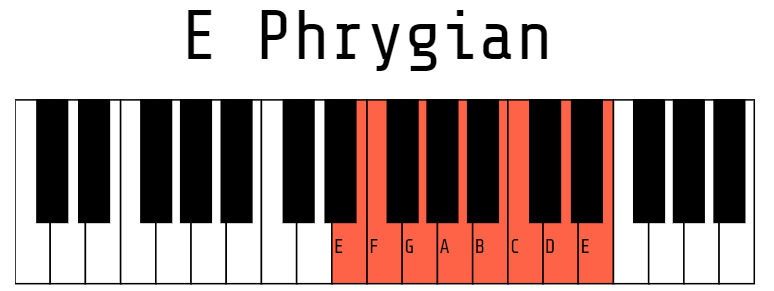Phrygian scale (phrygian mode)
Phrygian Mode Scale
The Phrygian mode is a musical scale that is often associated with a minor sound but has a unique characteristic: a flattened second degree.
The formula for the Phrygian mode scale is: S - T - T - T - S - T - T
- Start on any note (tonic)
- Move up a half step (S)
- Move up a whole step (T)
- Move up a whole step (T)
- Move up a whole step (T)
- Move up a half step (S)
- Move up a whole step (T)
- Move up a whole step (T)
For example, if we start on the note E, applying the formula gives us the E Phrygian mode scale:
- E - F - G - A - B - C - D - E

Phrygian Mode Characteristics
The Phrygian mode is a unique scale that stands out due to its distinctive interval pattern and the particular mood it creates.
Here are a few key aspects that make the Phrygian mode special and differentiate it from other scales:
- Flattened 2nd Degree: The Phrygian mode is characterized by its flattened second degree, giving it a distinct and exotic quality.
- Minor Sound: The Phrygian mode is often associated with a minor tonality due to its minor third and minor seventh.
- Spanish and Flamenco Vibes: The Phrygian mode is commonly used in Spanish and flamenco music, adding a passionate and intense flavor to the compositions.
- Tense and Dark: The Phrygian mode has a darker and more tense sound compared to other minor scales, providing a unique emotional impact.
- Harmonic Possibilities: The interval pattern of the Phrygian mode allows for interesting chord progressions and harmonizations, making it versatile for creating unique musical compositions.
Overall, the Phrygian mode's unique qualities make it a favorite among musicians and composers seeking to explore different tonal flavors and evoke specific moods in their music.
Famous Songs in Phrygian Mode
Here are a few examples of famous songs that utilize the Phrygian mode:
- "Infant Eyes" - Wayne Shorter
- "After the Rain" - John Coltrane
- "Wherever I May Roam" - Metallica
- "Remember tomorrow" - Iron Maiden
- "Symphony of destruction" - Megadeth
- "War" - Joe Satriani
These songs incorporate elements of the Phrygian mode either in their melodies, chord progressions, or improvisations. They demonstrate the versatility and richness of the Phrygian mode in various musical genres.
Keep in mind that the Phrygian mode might be present in certain sections of these songs or used as a basis for improvisation, rather than being the entire composition.
Chords in E Phrygian Mode
Triads:
- Em (E minor): E - G - B
- F (F major): F - A - C
- G (G major): G - B - D
- Am (A minor): A - C - E
- Bdim (B diminished): B - D - F
- C (C major): C - E - G
- Dm (D minor): D - F - A
Quadriads:
- Em7 (E minor 7): E - G - B - D
- Fmaj7 (F major 7): F - A - C - E
- G7 (G dominant 7): G - B - D - F
- Am7 (A minor 7): A - C - E - G
- Bm7b5 (B half-diminished 7): B - D - F - A
- Cmaj7 (C major 7): C - E - G - B
- Dm7 (D minor 7): D - F - A - C
These chords are derived by stacking thirds (either major or minor) on each degree of the E Phrygian mode. The resulting triads consist of three notes, while the quadriads consist of four notes.
Feel free to experiment with these chords to create chord progressions or use them as a starting point for your musical compositions.